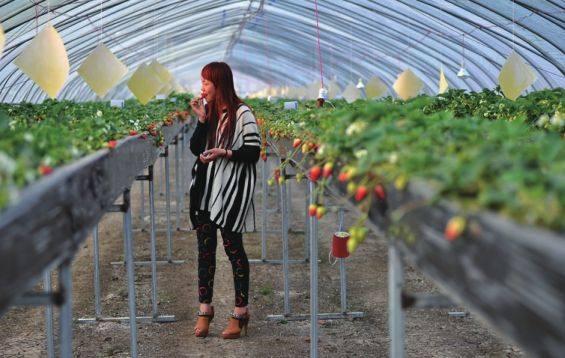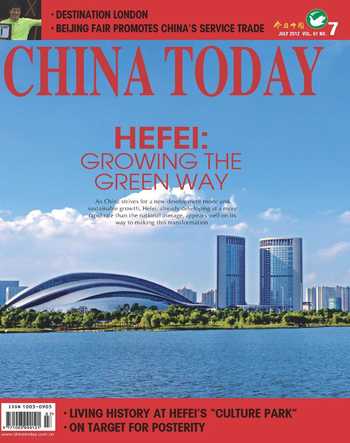Hefei’s Low-carbon Development
By TANG SHUBIAO & LI WUZHOU



ALTHOUGH adjacent to the Yangtze River Delta Economic Zone, Hefei belongs to Central China and its economic development lags behind eastern coastal cities. Traditionally an agricultural area, with per capita arable land of just 0.1 hectare, it is impossible for the millions of farmers that make up most of the citys population to get rich. A solution to this is industrialization and urbanization, a course that Hefei has been pursuing for the past few years. All around the city, new apartment buildings are springing up to accommodate the rural laborers that are flowing into the city. These laborers find jobs at the newly built factories scattered in the development zones in Hefeis suburbs. Many of these factories have moved from the economically developed eastern regions to take advantage of cheaper labor costs here. The factories still have to cope with scarce resources and energy, however, and Hefei must become more efficient by upgrading existing industries and prioritizing the development of hi-tech industry, strategic emerging industries and modern services.
In 2011, Hefeis GDP reached RMB 363.6 billion, an increase of 15.4 percent over the previous year, making it, for the seventh year running, one of the fastest growing provincial capitals nationwide and the fastest in Central China. More significantly, perhaps, 2011 also saw the disposable income of Hefeis urban residents surpassing the national average for the first time.
Green Companies only
There is a tangible enthusiasm for attracting investment and boosting industrial growth among Hefeis leaders. Last year the local government organized an impressive 3,000 teams to draw investors to this city of more than seven million people.
Such efforts have had pleasing results. From 2006 to 2010, Hefei saw over 2,000 new industrial projects and 1,423 new industrial enterprises. In 2011 alone, the city drew in RMB 170 billion, a staggering growth of 30 percent over the previous year.
Although the government is eager for development, it is careful to make decisions and makes sure that its development is balanced. While working to change its development mode, Hefei has established large and comprehensive industrial zones and created complete industrial chains, greatly sharpening local industries competitive edge. More than 70 percent of its output is made with locally produced components, reducing the need for transport and cutting both costs and carbon emissions. It is home to several national industrial zones including those specialized in producing household appliances and flat panel displays. Hefei is now Chinas biggest producer of television sets, washing machines, fridges and airconditioners.
In 2010, the value of Hefeis household appliance industry hit RMB 100 billion, and the equipment manufacturing industry reached the same milestone the following year. In the next five years, the output of flat panel displays, household appliances and the new energy industry are forecast to double that sum not collectively, but each, and the auto industry and food and agricultural product processing industry are both expected to rake in RMB 100 billion each.
The government is also doing a lot to encourage hi-tech and emerging industries. Hefei has led the country in developing and producing flat panel displays, solar photovoltaic products, new-energy vehicles and products related to public security. Many local enterprises engaged in those fields have made brilliant achievements and built their reputations nationwide.
Putting it briefly, the government has steered away from the outdated development path of high energy consumption and high pollution, and shifted to a development mode with low emissions, favoring environmentally friendly enterprises and refusing those that do not meet its energy and environmental requirements. With this policy, Hefeis energy consumption per RMB 10,000 of GDP dropped 22 percent from 2006 to 2010. It is currently only half of the provincial average.
Local banks are also doing their part to encourage enterprises to take a low-carbon approach to development, limiting loans to enterprises whose projects cannot meet environmental protection requirements. Energy conservation, emission reduction and technological upgrading are all features that the banks prefer when approving project loans.
Wu Cunrong, secretary of the CPC Hefei Municipal Committee, is adamant that Hefeis development must be sustainable and that it will not follow the developed areas that thoughtlessly burned up energy and polluted the environment first and wor- ried about reducing and controlling pollutants later. “Environmental protection is paramount for the development of central and western China,” Wu said.
High Profits, Low Emissions

In their exhibition room, BOE Technology Group shows off one of its low energy TV screens. This TV screen requires only 53 watts, while most TV screens of the same size on the market require 74.4 watts. Meanwhile, Hefei Rongshida Sanyo Electric has developed a washing machine that saves energy by automatically adjusting its power to different laundry needs.
Existing industries have upgraded their technology to save energy, and industrial zones have become more and more environmentally friendly. Hefei Hi-tech Development Zone is Anhui Provinces first National Ecological Industrial Demonstration Park. The zone is home to a dozen or so enterprises approved by the Anhui Environmental Protection Industry Association, including Hefei Rongshida Sanyo Electric, Anhui Clean Environment and Biotechnology, and Wayee Technology.
In order to guarantee low-carbon development, enterprises in Hefei not only employ low-carbon production techniques but also produce low-carbon products. Two of its six pillar industries, new energy vehicles and photovoltaic products, are concerned with the utilization of new, renewable energy.
Currently Hefei has 25 auto enterprises that have formed a complete industrial chain. Their businesses range from the development and production of vehicles, batteries, engines and management systems to the construction of charging stations. Among the companies operating in Hefei is Anhui Ankai Automobile, which produces an electric bus that only consumes 1.4 kWh of electricity per kilometer, even with the air-conditioner on. Its operating cost is half that of a diesel bus of same capacity. In 2011 this model won Ankai a deal worth US $152 million, bigger than any other Chinese bus export deal to date.
In recent years Hefei has invested heavily in developing its solar photovoltaic industry, whose total production is expected to reach RMB 100 billion in the near future. Although the domestic solar photovoltaic industry is going through a difficult period, Anhui Hareon Solar Company has seen a growth. The company invested RMB 2.43 billion in early 2011 and its 40 high-efficiency solar cells production lines have been operating at full production capacity. Business is good, and the company plans to invest in another 120 solar cells production lines.
Anhui Hareon Solar Company is just one of companies in Hefei that specialize in renewable energy. Sungrow Power Supply, whose operation covers the whole production process, starting with design, has become Chinas largest manufacturer of photovoltaic inverters and wind energy converters.
Furthermore, Hefei will soon become a major source of clean electricity. Several stations that are part of the RMB 482 million China Golden Sun Project in Hefei are already in operation, with the remaining stations close to completion. When the project is completed, these stations will generate 15 million kWh of electricity per year.
Low Carbon Streets
Environmentally friendly development is not limited to Hefeis businesses, however. In the streets one can see buses and taxies fueled by natural gas, and many buses and private cars run on electricity.
Hefei is bringing electric vehicles (EVs) onto the market on a larger scale than anywhere else. This year, Hefei plans to produce 10,000 electric cars. It was the first city to run a bus line entirely serviced by electric buses. The fleet of 30 EVs will be responsible for over 1,500 tons of carbon emission savings every year they ferry Hefeis residents around the city.
Their journeys are also lit by energy-saving lighting, and around 80 percent of the citys decorative lighting uses LED bulbs. The road lighting has been replaced with high-efficiency sodium high-pressure lights. This will save Hefei about six million kWh every year.
Even the roads the EVs drive on are environmentally friendly. Since 2010, road renovation has used a special technology that reclaims the surface of old asphalt roads and adds a stabi- lizer to it to form an energy-saving composite material called asphalt concrete.
Hefeis new buildings are also part of the governments efforts to create a green city. In 2009, Hefei was chosen as one of 26 cities that demonstrate the use of renewable energy in buildings and won national subsidies to carry out further development. The local government also provides subsidies for buildings that incorporate the use of solar or geothermal energy.
Whats more, local government has begun to use methane from landfill sites to power the city. The three generators at the Longquanshan Landfill Gas Power Plant have created a total of 36.35 million kWh of electricity, equivalent to that produced by 12,000 tons of coal.
Many modern farms and agricultural enterprises have been established in rural Hefei, from Chinas largest coarse grains processing enterprise to dairy cow breeding centers. While doing so, Hefei is making sure its efforts in environmental protection extend to all parts of its territory. Hilly farmland is planted with forest, farmers combat pests by introducing natural predators so they reduce or even stop the use of chemical pesticides, and, in Sanhe Town of Feixi County, residents have preserved their traditional way of living and architecture in order to develop tourism.
Rural Hefei has also seen the emergence of a new profession– methane supervisor. The 153 methane supervisors in Hefei are responsible for building and maintaining methane tanks as a result of the increasing use of the gas in Hefeis countryside. Thanks to government subsidies, 43,500 Hefei households are now equipped with methane tanks whose contents are used for energy production.
Hefeis endeavors to create a sustainable, environmentally friendly city have touched everywhere from industrial parks to strawberry farms. With economic development high on its list of priorities, many of Hefeis advances in this respect have not been easy, while others have helped it establish itself as a major player in producing green products. Thanks to efforts by the local government, big businesses, and its methane gas supervisors, Hefei is well on the way to achieving its goals.



